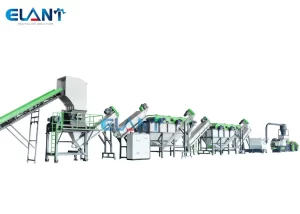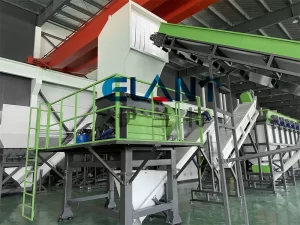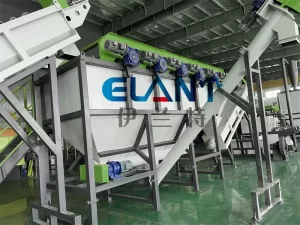Introduction to PP and PE Film Recycling
Plastic waste is a major environmental issue, and recycling plays a crucial role in reducing its impact. Among various recycling processes, the PP PE film washing line has emerged as an essential system for transforming waste polypropylene (PP) and polyethylene (PE) films into reusable materials. This process enhances sustainability by ensuring that plastic films from packaging, agriculture, and industry are efficiently cleaned and prepared for reuse.
What is a PP PE Film Washing Line?
A PP PE film washing line is an advanced recycling setup designed to clean contaminated plastic films. Since PP and PE films often contain dirt, oil, labels, and adhesives, traditional recycling methods alone are ineffective. This washing line incorporates specialized machinery to remove these impurities, ensuring a high-purity end product ready for further processing.

Key Stages of the PP PE Film Washing Process
1. Pre-Cutting and Shredding
Large plastic films are shredded into smaller pieces, making them easier to process. Shredders and granulators break down bulky films, improving washing efficiency and overall recycling performance.
2. Pre-Washing
Pre-washing removes surface dirt, sand, and debris, reducing the load on later cleaning stages. This step often involves agitated water tanks or paddle washers that loosen contaminants from the plastic surface.
3. High-Speed Friction Washing
Friction washers use high-speed rotors to scrub contaminants like grease and adhesive residues. This stage ensures deep cleaning, significantly improving the quality of recycled material.
4. Hot Washing
A hot wash using heated water and detergents further eliminates persistent contaminants, such as oils and glue. This is essential for films used in industrial applications where contamination is higher.
5. Separation and Rinsing
A separation tank is used to distinguish clean plastic fragments from impurities. Lighter plastic floats while heavier contaminants sink, ensuring that only clean material advances for drying.
6. Drying and Quality Control
After washing, plastic film undergoes dewatering and drying to remove moisture. Quality checks ensure the final product meets recycling standards, making it suitable for resale or reuse.
Essential Machinery in a PP PE Film Washing Line
Shredders and Granulators – Reduce plastic size for effective washing
Friction Washers – Remove grease and stubborn contaminants
Hot Wash Tanks – Apply heat and detergents for deep cleaning
Separation Tanks – Separate plastics from debris
Key Stages of the PP PE Film Washing Process
1. Pre-Cutting and Shredding
Large plastic films are shredded into smaller pieces, making them easier to process. Shredders and granulators break down bulky films, improving washing efficiency and overall recycling performance.
2. Pre-Washing
Pre-washing removes surface dirt, sand, and debris, reducing the load on later cleaning stages. This step often involves agitated water tanks or paddle washers that loosen contaminants from the plastic surface.
3. High-Speed Friction Washing
Friction washers use high-speed rotors to scrub contaminants like grease and adhesive residues. This stage ensures deep cleaning, significantly improving the quality of recycled material.
4. Hot Washing
A hot wash using heated water and detergents further eliminates persistent contaminants, such as oils and glue. This is essential for films used in industrial applications where contamination is higher.
5. Separation and Rinsing
A separation tank is used to distinguish clean plastic fragments from impurities. Lighter plastic floats while heavier contaminants sink, ensuring that only clean material advances for drying.
6. Drying and Quality Control
After washing, plastic film undergoes dewatering and drying to remove moisture. Quality checks ensure the final product meets recycling standards, making it suitable for resale or reuse.

Essential Machinery in a PP PE Film Washing Line
Shredders and Granulators – Reduce plastic size for effective washing
Friction Washers – Remove grease and stubborn contaminants
Hot Wash Tanks – Apply heat and detergents for deep cleaning
Separation Tanks – Separate plastics from debris
Dewatering Machines & Dryers – Ensure moisture-free output ready for reuse
Benefits of PP PE Film Washing Lines
1. Environmental Sustainability
By recycling waste plastic, PP PE film washing lines reduce landfill waste and support a circular economy, minimizing dependence on virgin plastics.
2. Cost-Effective for Recycling Facilities
Although the initial investment in a washing line is high, it enables cost savings by producing consistent-quality recycled material, reducing reliance on expensive raw plastics.
3. High-Quality Recycled Material
A well-designed washing process ensures purity and usability, making the recycled plastic suitable for packaging, construction, and automotive applications.

Challenges and Solutions in PP PE Film Washing
1. Managing Contamination
Plastic films often contain heavy contamination, requiring efficient pre-sorting and advanced washing equipment to ensure effective cleaning.
2. Water and Energy Consumption
The process involves high water and energy use, but closed-loop water systems and energy-efficient machines help minimize resource consumption while maintaining effectiveness.
Conclusion: The Role of PP PE Film Washing Lines in Recycling
The PP PE film washing line is a vital technology in modern recycling, helping transform waste into valuable reusable materials. By improving contamination removal and processing efficiency, these systems support global sustainability efforts and enhance the viability of plastic recycling. Investing in advanced washing technology ensures better environmental outcomes and economic benefits for recycling facilities worldwide.
